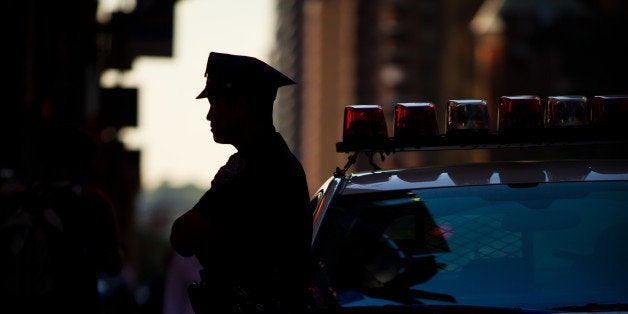
In a recent interview with the New York Times, Police Chief William Bratton stated his intention to bring "predictive policing" technologies to New York. As a strong proponent of predictive policing in Los Angeles and other places, the question remains only when Chief Bratton will adopt these predictive policing technologies to replace or supplement the NYPD's troubled "stop and frisk" practices.
What is predictive policing and how does it work? Predictive policing works by taking regularly recorded crime data -- location, time, and crime -- and inputting it all into sophisticated computer models that predict places of expected criminal activity. The predictions are narrowly tailored, limited to 500-by-500-square foot areas, and short-lived, usually updated on a daily basis. Police officers are then deployed to those identified areas to deter crime from happening. Initial studies in Los Angeles and Santa Cruz, California, have been quite successful as crime rates for targeted crimes have dropped in the designated areas.
This isn't science fiction; it is actually some rather old social science wrapped up in new "big data" analytics. The key insight is that certain crimes -- burglary, car theft, and theft from automobiles -- are rather dependent on place and opportunity. If you successfully burglarize one house in a neighborhood, you may be encouraged to try another in the same area. After all, houses in many places are built the same (so structural vulnerabilities may exist), or perhaps it is an area without a police presence (or bad lighting), or maybe you have learned the escape routes, or maybe you or your compatriots in crime are plain lazy and want to try the same score again. Whatever the reason, these vulnerable areas are recognized by criminals and crime returns almost like a contagious virus. Social scientists have been documenting this reality for decades across a variety of countries and research test sites.
What predictive policing has done is put the power of big data analytics behind the insight that environmental vulnerabilities can be identified, mapped, and targeted for intervention. This task is now in the hands of crime analysts and private companies using new algorithms to crunch the ever increasing crime statistics that are now a routine part of police work.
Is this innovation a good thing? Certainly, crime going down is a good thing. Similarly, data driven metrics seems to be a smarter way to allocate scarce police resources compared to tradition, gut instinct, or political pressure. And, if the goal is simply to put officers in the right place at the right time to discourage crime from happening, it seems like a wise use of resources.
So, should we be concerned that a black box computer program is directing law enforcement suspicion of certain areas? Maybe. Here are five questions that citizens in New York and elsewhere should consider before joining the rush to predictive policing.
1. How good are the data? Predictive policing is only as good as the data going into the system. Crimes must be reported, recorded, inputted, and analyzed, and human failure along any of the points undermines the analytics. Mistakes will be made, and currently, since all the data collection and analysis is held by law enforcement or private companies there are few mechanisms for external accountability or correction. As last year's audit of the NYPD's crime statistics showed, crime data is vulnerable to manipulation and error.
2. How do we know the technology works? Predictive policing is based on algorithms only a few people understand. Further, most are proprietary, carefully controlled by the companies that developed them. And, of course, police do not want to reveal how or where they hope to catch the bad guys. This reality prevents outside observers from judging whether the analytics work, what is being inputted, and whether the data is clean, complete, accurate, and reliable. A few recent reports have begun to question how "success" is judged by those promoting the technology.
3. What types of crime can be predicted? Assuming that predictive policing works for burglaries and car thefts, can it be used for other types of crime? Jurisdictions are already adapting the technology to predict violent crimes and gang crimes. It may be that similar environmental vulnerabilities exist in robberies or gang shootings over gang turf, but the social science data remains comparatively limited about the ability to predict violent crime.
4. Are there constitutional concerns? The Fourth Amendment protects citizens on the streets from unreasonable searches and seizures by police. The question remains how a predictive tip will affect Fourth Amendment rights for citizens who happen to be located in one of those 500-by-500 square foot boxes of predicted criminal activity. Will officers be given greater latitude to stop individuals in that mapped area? Will courts be willing to defer to an algorithm to determine the "high crime areas" in a city? Will "stop and frisk" be replaced by predictive reasonable suspicion? These questions have not yet been answered, but will soon confront courts in predictive policing jurisdictions.
5. Are predictive policing technologies the best use of limited resources? The initial success of predictive policing has created a lot of positive buzz. There is a real temptation for Chief Bratton to offer New York this new "magic bullet" to reduce crime, especially at a time when the city is looking for ways to turn the page on federal lawsuits and the policies of the previous administration. While predictive policing may work for some crimes and some cities, the danger will be that these predictive tools will stray from their original roots, expanding to different types of crime, cities, and circumstances without considered thought.
These concerns, while real, do not detract from the unquestionable innovation behind predictive policing. For certain types of crimes, we now have new tools to deter potential crime targets. And, at the very least, the process of identifying these predicted areas should cause city officials and police officers to identify (and address) environmental vulnerabilities in their city. The future is now, and if Chief Bratton can answer these questions, one can predict increasing use of predictive technologies in New York and in cities across America.
